15.2 The Biomedical Therapies and Preventing Psychological Disorders
Psychotherapy is one way to treat psychological disorders. The other is biomedical therapy—
Drug Therapies
15-
psychopharmacology the study of the effects of drugs on mind and behavior.
Since the 1950s, discoveries in psychopharmacology (the study of drug effects on mind and behavior) have revolutionized the treatment of people with severe disorders. Thanks to drug therapy and support from community mental health programs, today’s resident population of U.S. state and county mental hospitals has dropped to a small fraction of what it was a half-

Many new treatments are greeted by an initial wave of enthusiasm as many people apparently improve. But that enthusiasm often diminishes after researchers subtract the rates of (1) normal recovery among untreated persons and (2) recovery due to the placebo effect, which arises from the positive expectations of patients and mental health workers alike. Even mere exposure to advertising about a drug’s supposed effectiveness can increase its effect (Kamenica et al., 2013). To control for these influences when testing a new drug, researchers give half the patients the drug, and the other half a similar-
Antipsychotic Drugs
antipsychotic drugs drugs used to treat schizophrenia and other forms of severe thought disorder.
An accidental discovery launched a treatment revolution for people with psychosis. The discovery was that some drugs used for other medical purposes calmed the hallucinations or delusions that are part of these patients’ split from reality. First-
The molecules of most conventional antipsychotic drugs are similar enough to molecules of the neurotransmitter dopamine to occupy its receptor sites and block its activity. This finding reinforces the idea that an overactive dopamine system contributes to schizophrenia.
Antipsychotics also have powerful side effects. Some produce sluggishness, tremors, and twitches similar to those of Parkinson’s disease (Kaplan & Saddock, 1989). Long-
Perhaps you can guess an occasional side effect of L-
Despite their drawbacks, antipsychotics, combined with life-
Antianxiety Drugs
antianxiety drugs drugs used to control anxiety and agitation.
Like alcohol, antianxiety drugs, such as Xanax or Ativan, depress central nervous system activity (and so should not be used in combination with alcohol). Antianxiety drugs are often successfully used in combination with psychological therapy. Experiments indicate that a drug can enhance exposure therapy’s extinction of learned fears and help relieve the symptoms of posttraumatic stress disorder and obsessive-
One criticism made of antianxiety drugs is that they may reduce symptoms without resolving underlying problems, especially if used as an ongoing treatment. “Popping a Xanax” at the first sign of tension can create a learned response; the immediate relief reinforces a person’s tendency to take drugs when anxious. Anxiety drugs can also be addictive. Regular users who stop taking antianxiety drugs may experience increased anxiety, insomnia, and other withdrawal symptoms.
Over the dozen years at the end of the twentieth century, the rate of outpatient treatment for anxiety disorders, obsessive-
Antidepressant Drugs
antidepressant drugs drugs used to treat depression, anxiety disorders, obsessive-
The antidepressant drugs were named for their ability to lift people up from a state of depression. Until recently, this was their main use. These drugs are now increasingly used to treat anxiety disorders, obsessive-
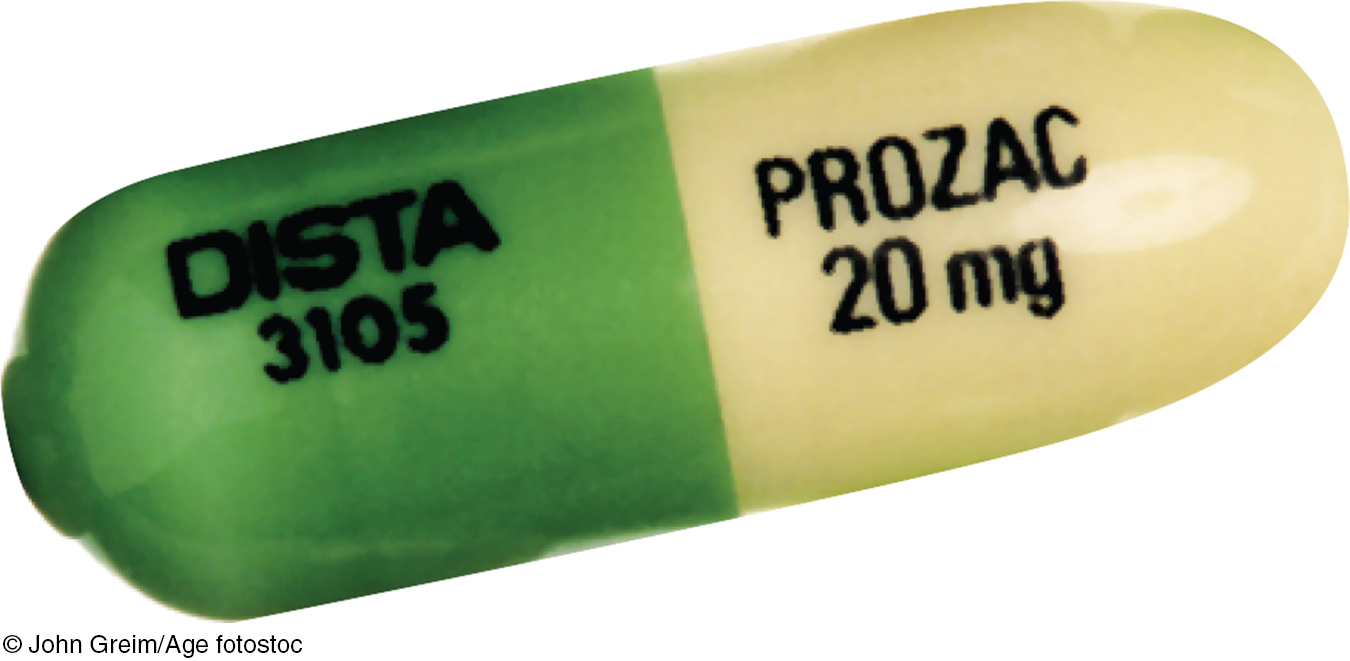
The most commonly prescribed drugs in this group, including Prozac and its cousins Zoloft and Paxil, work by blocking the normal reuptake of excess serotonin from synapses (FIGURE 15.5). Given their use in treating disorders other than depression, from anxiety to strokes, these drugs are most often called SSRIs—
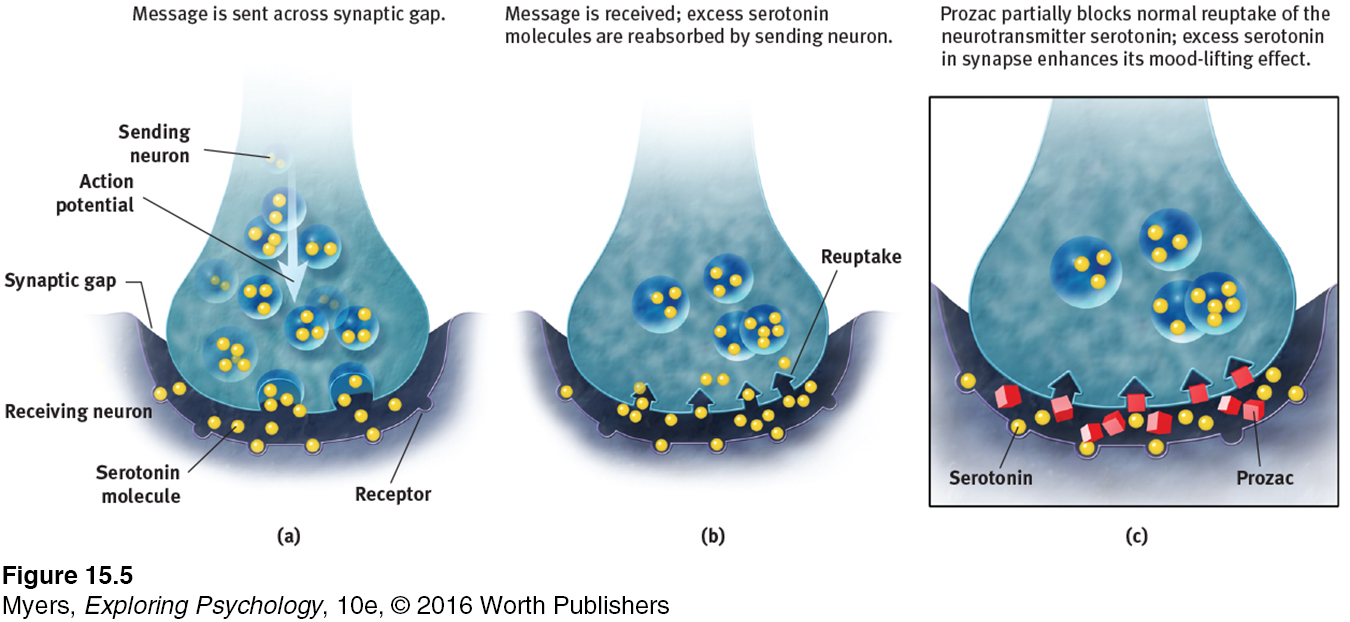
Some of the older antidepressant drugs work by blocking the reabsorption or breakdown of both norepinephrine and serotonin. Though effective, these dual-
Be advised: Patients with depression who begin taking antidepressants do not wake up the next morning singing “It’s a beautiful day!” Although the drugs begin to influence neurotransmission within hours, their full psychological effect often requires four weeks (and may involve a side effect of diminished sexual desire). One possible reason for the delay is that increased serotonin promotes new synapses plus neurogenesis—the birth of new brain cells, reversing stress-
Antidepressant drugs are not the only way to give the body a lift. Aerobic exercise, which calms people who feel anxious and energizes those who feel depressed, does about as much good as antidepressant drugs for most people with mild to moderate depression, and has additional positive side effects. Cognitive therapy, which helps people reverse their habits of thinking negatively, can boost the drug-

Researchers generally agree that people with depression often improve after a month on antidepressant drugs. But after allowing for natural recovery and the placebo effect, how big is the drug effect? Not big, report some researchers (Kirsch et al., 1998, 2002, 2010, 2014). In double-
“No twisted thought without a twisted molecule.”
Attributed to psychologist Ralph Gerard
 IMMERSIVE LEARNING To better understand how clinical researchers have evaluated drug therapies, complete LaunchPad’s How Would You Know How Well Antidepressants Work?
IMMERSIVE LEARNING To better understand how clinical researchers have evaluated drug therapies, complete LaunchPad’s How Would You Know How Well Antidepressants Work?
Mood-Stabilizing Medications
In addition to antipsychotic, antianxiety, and antidepressant drugs, psychiatrists have mood-
Australian physician John Cade discovered the benefits of lithium in the 1940s when he administered it to a patient with severe mania and the patient became well in less than a week (Snyder, 1986). About 7 in 10 people with bipolar disorder benefit from a long-
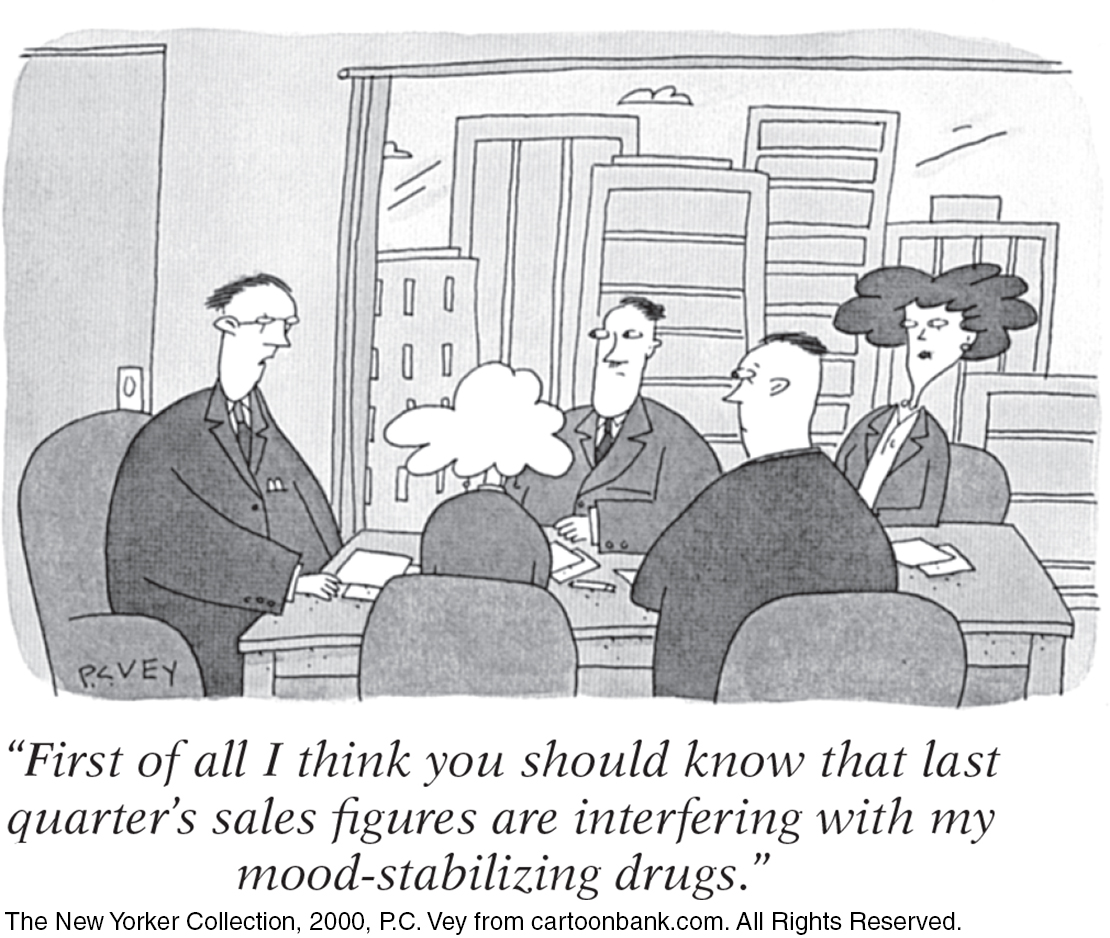
RETRIEVE IT
Question
How do researchers evaluate the effectiveness of particular drug therapies?
Question
The drugs given most often to treat depression are called . Schizophrenia is often treated with drugs.
Brain Stimulation
15-
Electroconvulsive Therapy
electroconvulsive therapy (ECT) a biomedical therapy for severely depressed patients in which a brief electric current is sent through the brain of an anesthetized patient.
Another biomedical treatment, electroconvulsive therapy (ECT), manipulates the brain by shocking it. When ECT was first introduced in 1938, the wide-
The medical use of electricity is an ancient practice. Physicians treated the Roman Emperor Claudius (10 B.C.E.-54 C.E.) for headaches by pressing electric eels to his temples.
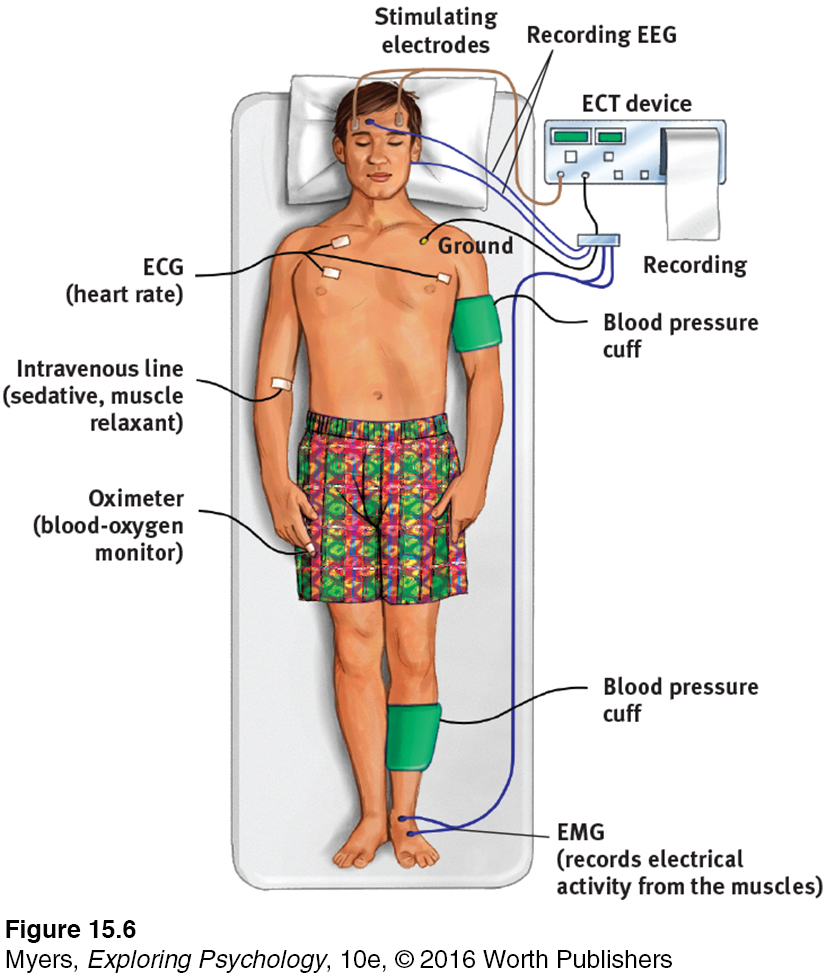
Study after study confirms that ECT can effectively treat severe depression in “treatment-
“I used to … be unable to shake the dread even when I was feeling good, because I knew the bad feelings would return. ECT has wiped away that foreboding. It has given me a sense of control, of hope.”
Kitty Dukakis (2006)
How does ECT relieve severe depression? After more than 70 years, no one knows for sure. One patient likened ECT to the smallpox vaccine, which was saving lives before we knew how it worked. Perhaps the brief electric current calms neural centers where overactivity produces depression. Some research indicates that ECT works by weakening connections in a “hyperconnected” neural hub in the left frontal lobe (Perrin et al., 2012).
No matter how impressive the results, the idea of electrically shocking people still strikes many as barbaric, especially given our ignorance about why ECT works. Moreover, about 4 in 10 people treated with ECT relapse into depression within six months (Kellner et al., 2006). Nevertheless, in the minds of many psychiatrists and patients, ECT is a lesser evil than severe depression’s misery, anguish, and risk of suicide. As research psychologist Norman Endler (1982) reported after ECT alleviated his deep depression, “A miracle had happened in two weeks.”
Alternative Neurostimulation Therapies
Two other neural stimulation techniques—
repetitive transcranial magnetic stimulation (rTMS) the application of repeated pulses of magnetic energy to the brain; used to stimulate or suppress brain activity.
MAGNETIC STIMULATION Depressed moods sometimes improve when repeated pulses surge through a magnetic coil held close to a person’s skull (FIGURE 15.7). The painless procedure—

Initial studies have found a small antidepressant benefit of rTMS (Lepping et al., 2014). How it works is unclear. One possible explanation is that the stimulation energizes the brain’s left frontal lobe (Helmuth, 2001). Repeated stimulation may cause nerve cells to form new functioning circuits through the process of long-
A meta-

DEEP BRAIN STIMULATION Other patients whose depression has resisted both drugs that flood the body and ECT that jolts at least half the brain have benefited from an experimental treatment pinpointing a brain depression center. Neuroscientist Helen Mayberg and her colleagues (2005, 2006, 2007, 2009) have been focusing on a neural hub that bridges the thinking frontal lobes to the limbic system. This area, which is overactive in the brain of a depressed or temporarily sad person, calms when treated by ECT or antidepressants. To experimentally excite neurons that inhibit this negative emotion-
RETRIEVE IT
Question
Severe depression that has not responded to other therapy may be treated with , which can cause brain seizures and memory loss. More moderate neural stimulation techniques designed to help alleviate depression include magnetic stimulation and stimulation.
Psychosurgery
psychosurgery surgery that removes or destroys brain tissue in an effort to change behavior.
lobotomy a psychosurgical procedure once used to calm uncontrollably emotional or violent patients. The procedure cut the nerves connecting the frontal lobes to the emotion-
Because its effects are irreversible, psychosurgery—surgery that removes or destroys brain tissue—
Although the intention was simply to disconnect emotion from thought, the effect was often more drastic. A lobotomy usually decreased the person’s misery or tension. But it also produced a permanently listless, immature, uncreative personality. During the 1950s, after some 35,000 people had been lobotomized in the United States alone, calming drugs became available and psychosurgery became scorned—
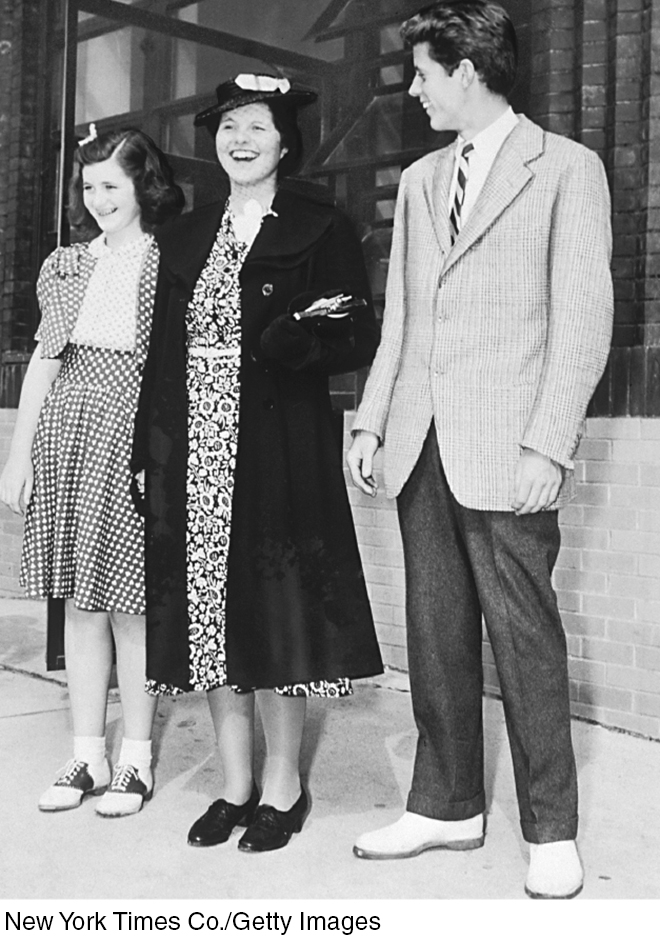
Today, lobotomies are history. More precise, microscale psychosurgery is sometimes used in extreme cases. For example, if a patient has uncontrollable seizures, surgeons can destroy the specific nerve clusters that cause or transmit the convulsions. MRI-
Therapeutic Lifestyle Change
15-
The effectiveness of the biomedical therapies reminds us of a fundamental lesson: We find it convenient to talk of separate psychological and biological influences, but everything psychological is also biological. Every thought and feeling depends on the functioning brain. Every creative idea, every moment of joy or anger, every period of depression emerges from the electrochemical activity of the living brain. The influence is two-
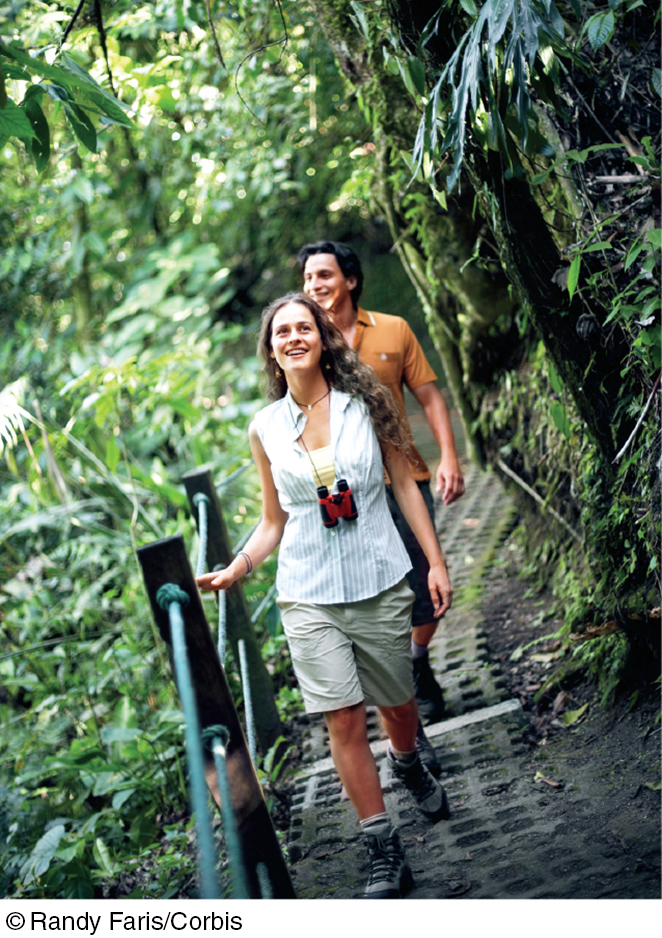
For years, we have trusted our bodies to physicians and our minds to psychiatrists and psychologists. That neat separation no longer seems valid. Stress affects body chemistry and health. Anxiety disorders, obsessive-
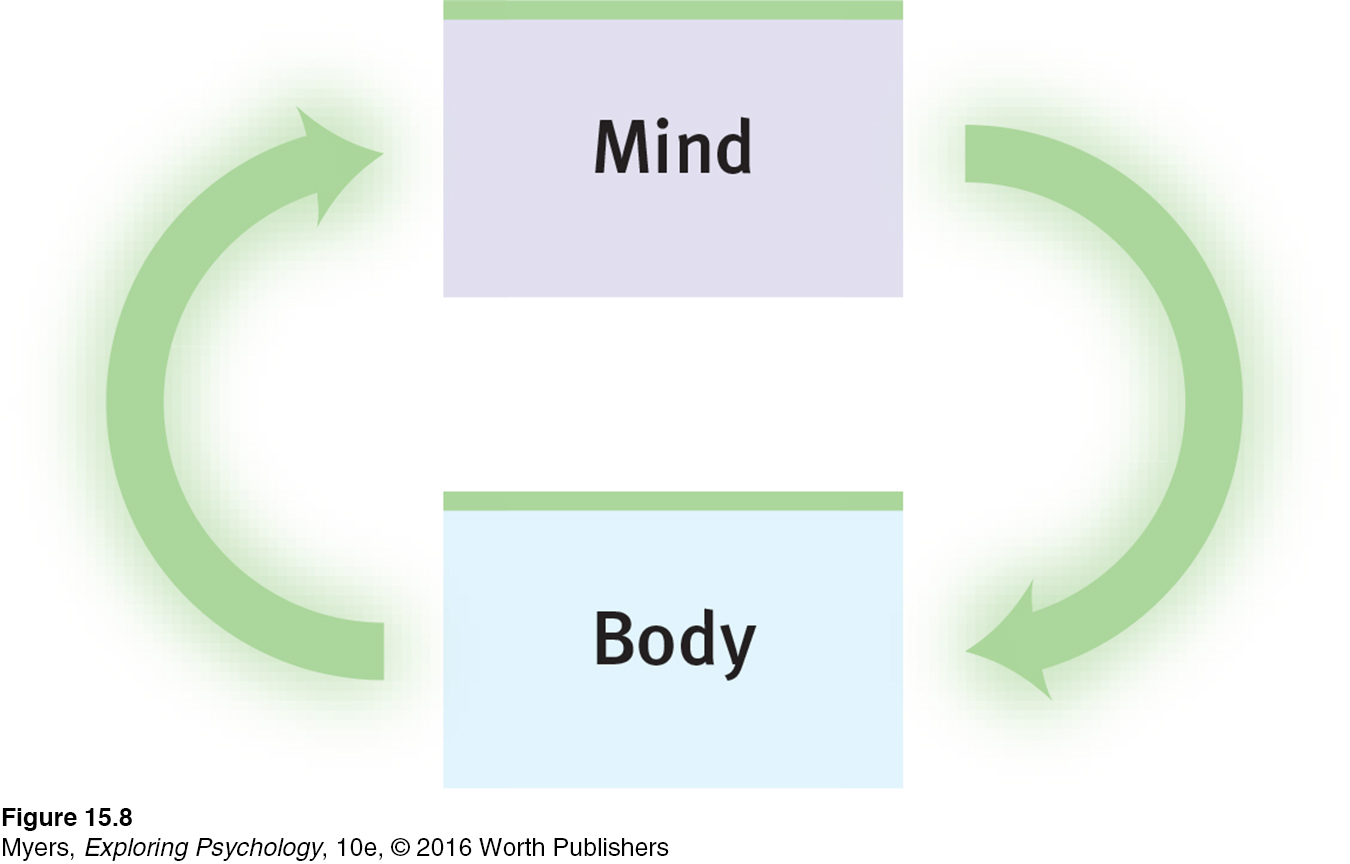
That lesson has been applied by Stephen Ilardi (2009) in training seminars promoting therapeutic lifestyle change. Human brains and bodies were designed for physical activity and social engagement, he notes. Our ancestors hunted, gathered, and built in groups. Indeed, those whose way of life entails strenuous physical activity, strong community ties, sunlight exposure, and plenty of sleep (think of foraging bands in Papua New Guinea, or Amish farming communities in North America) rarely experience depression. For both children and adults, outdoor activity in natural environments—
Ilardi was also impressed by research showing that regular aerobic exercise rivals the healing power of antidepressant drugs, and that a complete night’s sleep boosts mood and energy. So he invited small groups of people with depression to undergo a 12-
Aerobic exercise, 30 minutes a day, at least three times weekly (increases fitness and vitality, stimulates endorphins)
Adequate sleep, with a goal of 7 to 8 hours a night (increases energy and alertness, boosts immunity)
Light exposure, 15 to 30 minutes each morning with a light box (amplifies arousal, influences hormones)
Social connection, with less alone time and at least two meaningful social engagements weekly (helps satisfy the human need to belong)
Anti-
rumination, by identifying and redirecting negative thoughts (enhances positive thinking)Nutritional supplements, including a daily fish oil supplement with omega-
3 fatty acids (supports healthy brain functioning)

In one study of 74 people, 77 percent of those who completed the program experienced relief from depressive symptoms, compared with 19 percent in those assigned to a treatment-
TABLE 15.4 summarizes selected biomedical therapies.
Comparing Biomedical Therapies
| Therapy | Presumed Problem | Therapy Aim | Therapy Technique |
| Drug therapies | Neurotransmitter malfunction | Control symptoms of psychological disorders. | Alter brain chemistry through drugs. |
| Brain stimulation | Severe, treatment- |
Alleviate depression that is unresponsive to drug therapy. | Stimulate brain through electroconvulsive shock, magnetic impulses, or deep brain stimulation. |
| Psychosurgery | Brain malfunction | Relieve severe disorders. | Remove or destroy brain tissue. |
| Therapeutic lifestyle change | Stress and unhealthy lifestyle | Restore healthy biological state. | Alter lifestyle through adequate exercise, sleep, and other changes. |
RETRIEVE IT
Question
What are some examples of lifestyle changes we can make to enhance our mental health?
Preventing Psychological Disorders and Building Resilience
15-
Psychotherapies and biomedical therapies tend to locate the cause of psychological disorders within the person. We infer that people who act cruelly must be cruel and that people who act “crazy” must be “sick.” We attach labels to such people, thereby distinguishing them from “normal” folks. It follows, then, that we try to treat “abnormal” people by giving them insight into their problems, by changing their thinking, by helping them gain control with drugs.
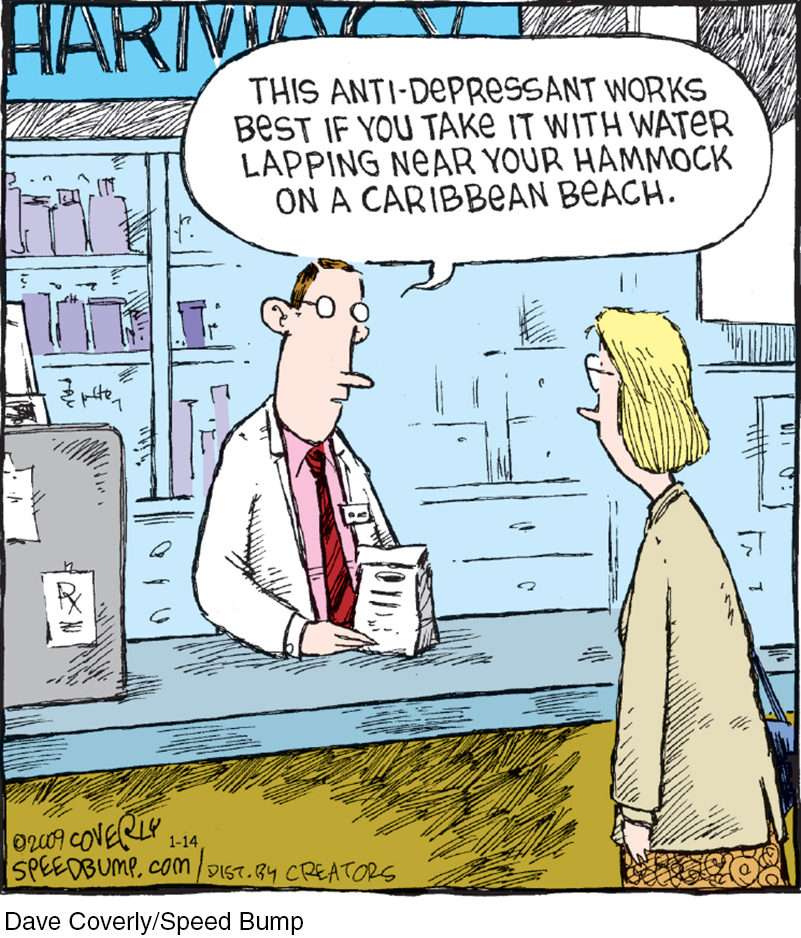
There is an alternative viewpoint: We could interpret many psychological disorders as understandable responses to a disturbing and stressful society. According to this view, it is not just the person who needs treatment, but also the person’s social context. Better to prevent a problem by reforming a sick situation and by developing people’s coping competencies than to wait for and treat problems.
Preventive Mental Health
A story about the rescue of a drowning person from a rushing river illustrates this viewpoint: Having successfully administered first aid to the first victim, the rescuer spots another struggling person and pulls her out, too. After a half-
“It is better to prevent than to cure.”
Peruvian folk wisdom
Preventive mental health is upstream work. It seeks to prevent psychological casualties by identifying and alleviating the conditions that cause them. As George Albee (1986; also Yoshikawa et al., 2012) pointed out, there is abundant evidence that poverty, meaningless work, constant criticism, unemployment, racism, and sexism undermine people’s sense of competence, personal control, and self-
“Mental disorders arise from physical ones, and likewise physical disorders arise from mental ones.”
The Mahabharata, 200 B.C.E.
We who care about preventing psychological casualties should, Albee contended, support programs that alleviate these demoralizing situations. We eliminated smallpox not by treating the afflicted but by inoculating the unafflicted. We conquered yellow fever by controlling mosquitoes. Preventing psychological problems means empowering those who have learned an attitude of helplessness and changing environments that breed loneliness. It means renewing fragile family ties and boosting parents’ and teachers’ skills at nurturing children’s competence and belief in their ability to grow. In short, “Everything aimed at improving the human condition, at making life more fulfilling and meaningful, may be considered part of primary prevention of mental or emotional disturbance” (Kessler & Albee, 1975, p. 557). Prevention can sometimes provide a double payoff. People with a strong sense of life’s meaning are more engaging socially (Stillman et al., 2011). If we can strengthen people’s sense of meaning in life, we may also lessen their loneliness as they grow into more engaging companions.
Among the upstream prevention workers are community psychologists. Mindful of how people interact with their environment, they focus on creating environments that support psychological health. Through their research and social action, community psychologists aim to empower people and to enhance their competence, health, and well-
Building Resilience
resilience the personal strength that helps most people cope with stress and recover from adversity and even trauma.
We have seen that lifestyle change can lessen psychological disorders. Might such change also prevent some disorders by building individuals’ resilience—the ability to cope with stress and recover from adversity? Faced with unforeseen trauma, most adults exhibit resilience. This was true of New Yorkers in the aftermath of the September 11 terror attacks, especially those who enjoyed supportive close relationships and who had not recently experienced other stressful events (Bonanno et al., 2007). More than 9 in 10 New Yorkers, although stunned and grief-
posttraumatic growth positive psychological changes as a result of struggling with extremely challenging circumstances and life crises.
Struggling with challenging crises can even lead to posttraumatic growth. Many cancer survivors have reported a greater appreciation for life, more meaningful relationships, increased personal strength, changed priorities, and a richer spiritual life (Tedeschi & Calhoun, 2004). Out of even our worst experiences, some good can come, especially when we can envision new possibilities (Roepke & Seligman, 2015). Through preventive efforts, such as community building and personal growth, fewer of us will fall into the rushing river of psychological -disorders.
RETRIEVE IT
Question
What is the difference between preventive mental health and psychological or biomedical therapy?
* * *
If you just finished reading this book, your introduction to psychological science is completed. Our tour of psychological science has taught us much—
With every good wish in your future endeavors,
David G. Myers
Nathan DeWall
REVIEW The Biomedical Therapies and Preventing Psychological Disorders
Learning Objectives
Test Yourself by taking a moment to answer each of these Learning Objective Questions (repeated here from within the chapter). Research suggests that trying to answer these questions on your own will improve your long-
Question
15-
Question
15-
Question
15-
Question
15-
Terms and Concepts to Remember
Test yourself on these terms.
Question
psychopharmacology (p. 593) antipsychotic drugs (p. 594) antianxiety drugs (p. 594) antidepressant drugs (p. 595) electroconvulsive therapy (ECT) (p. 597) repetitive transcranial magnetic stimulation (rTMS) (p. 598) psychosurgery (p. 599) lobotomy (p. 599) resilience (p. 603) posttraumatic growth (p. 603) | the application of repeated pulses of magnetic energy to the brain; used to stimulate or suppress brain activity. drugs used to treat depression, anxiety disorders, obsessive- the study of the effects of drugs on mind and behavior. drugs used to treat schizophrenia and other forms of severe thought disorder. the personal strength that helps most people cope with stress and recover from adversity and even trauma. a biomedical therapy for severely depressed patients in which a brief electric current is sent through the brain of an anesthetized patient. drugs used to control anxiety and agitation. surgery that removes or destroys brain tissue in an effort to change behavior. positive psychological changes as a result of struggling with extremely challenging circumstances and life crises. a psychosurgical procedure once used to calm uncontrollably emotional or violent patients. The procedure cut the nerves connecting the frontal lobes to the emotion- |
Experience the Testing Effect
Test yourself repeatedly throughout your studies. This will not only help you figure out what you know and don’t know; the testing itself will help you learn and remember the information more effectively thanks to the testing effect.
Question 15.17
1. Some antipsychotic drugs, used to calm people with schizophrenia, can have unpleasant side effects, most notably
| A. |
| B. |
| C. |
| D. |
Question 15.18
2. Drugs such as Xanax and Ativan, which depress central nervous system activity, can become addictive when used as ongoing treatment. These drugs are referred to as drugs.
Question 15.19
3. A simple salt that often brings relief to patients suffering the highs and lows of bipolar disorder is .
Question 15.20
4. When drug therapies have not been effective, electroconvulsive therapy (ECT) may be used as treatment, largely for people with
| A. |
| B. |
| C. |
| D. |
Question 15.21
5. An approach that seeks to identify and alleviate conditions that put people at high risk for developing psychological disorders is called
| A. |
| B. |
| C. |
| D. |
Use  to create your personalized study plan, which will direct you to the resources that will help you most in
to create your personalized study plan, which will direct you to the resources that will help you most in  .
.